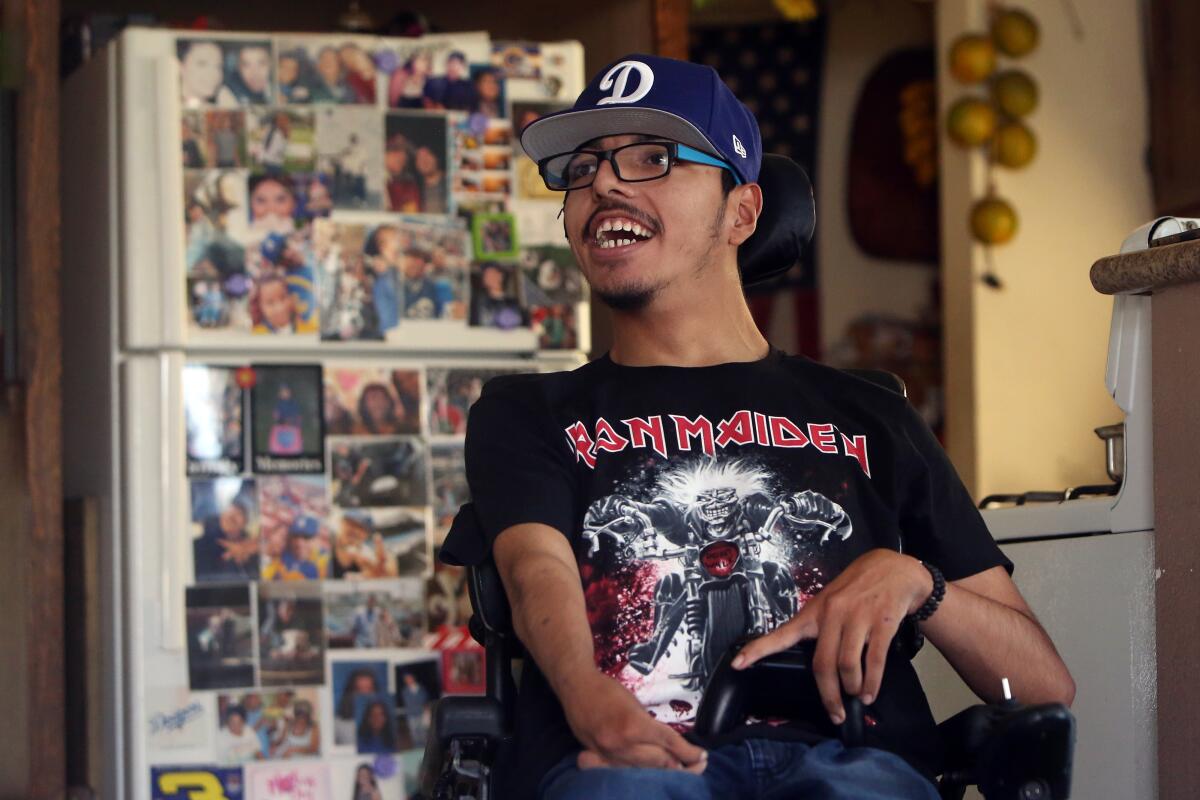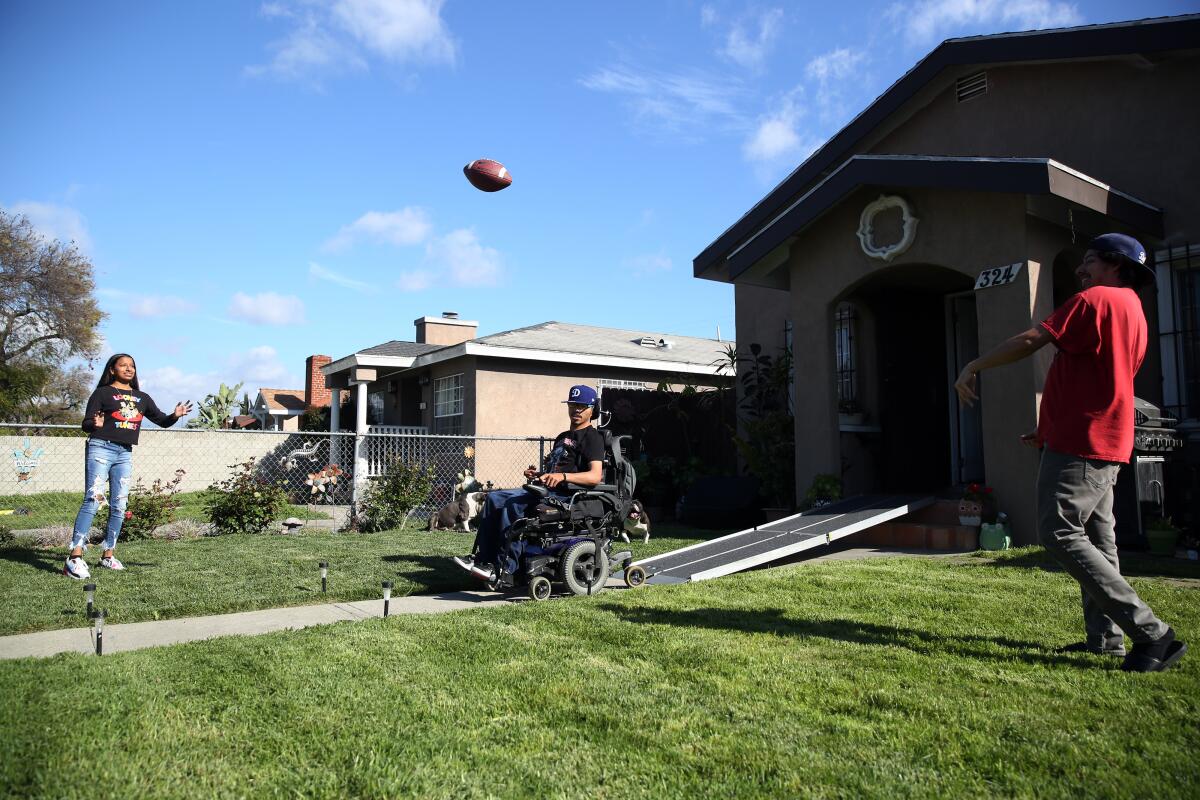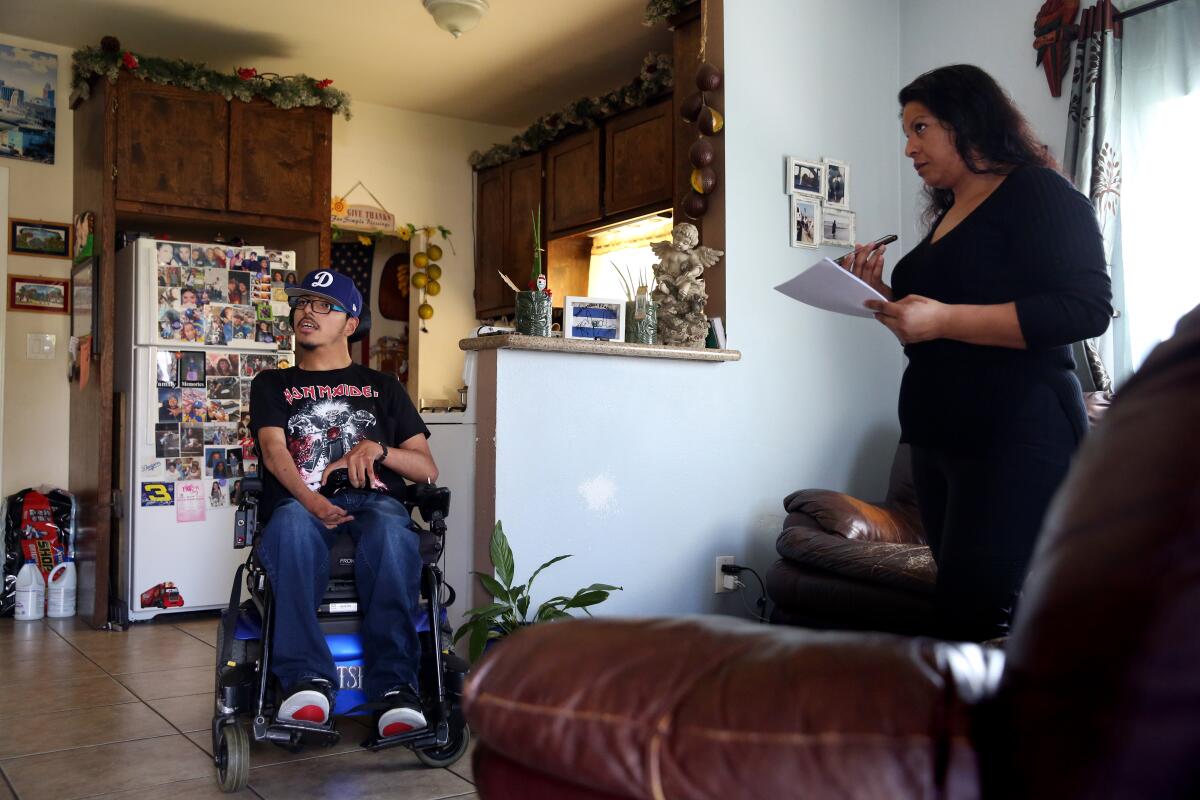Disability laws finally gave them an education. School-from-home threatens to make that impossible

Nine-year-old Trevor de la Torre was home with a migraine when his parents got word that his school was closing in response to the coronavirus emergency — and his critically needed hands-on therapies would effectively stop, too.
His one-on-one reading specialist, gone. His speech therapy, gone. His occupational therapist who is teaching him how to write letters, gone. His one-on-one classroom aide is no longer by his side to help him understand assignments and break down lessons into more manageable parts.
Trevor was born with a rare brain malformation called hemimegalencephaly — half his brain was removed when he was 6 months old to stop life-threatening seizures. He has only half of his vision and his mobility, as well as visual, auditory, speech and developmental delays, his mother, Kelly de la Torre, said.
Now the expert support team provided by the Poway Unified School District is only permitted by the district to wave a virtual hello and check in on video chat — and Kelly de la Torre is everything to her son.
“It’s a ton to be balanced. I felt very anxious this week and I don’t usually struggle with anxiety,” said de la Torre, who also has children who are 2 and 10 years old.

Students with disabilities and their parents, like the de la Torre family, were dealt a particularly harsh blow when the coronavirus emergency shut down California schools. Overnight, the intense hands-on assistance required for their children’s education and physical needs was no longer available, and in many cases not suitable for online learning.
Under federal education and civil rights law, public schools are required to provide equal educational resources to students with disabilities. School districts that do not meet the individual needs promised in personalized education plans could be at risk of losing federal funding.
Statewide, 767,560 California students, about 12% of the total, received special education services in 2017-18, according to the National Center for Education Services. In Los Angeles public schools alone, there are about 70,000 special education students, according to the superintendent.
In a webinar for special education teachers and administrators Thursday, officials from the California Department of Education and schools around the state said while they have started offering virtual services for students with disabilities, many are still trying to adapt. Hundreds of questions have poured in from schools about how to maintain these services for students, said Kristin Wright, director of CDE’s special education division.
“We understand the urgency as you continue to plan and implement, how to discuss, deliver and document what you’re doing to serve our students with disabilities in some very new and innovative ways,” said Wright, who also has a child with disabilities. “As we’ve been working as a state on increasing inclusion in our schools and in our communities, this temporary departure to a virtual world, into our homes, is extremely challenging.”
The pressure on parents, many attempting to juggle their own jobs from home, has been great.
“All of a sudden I’m the teacher and I’m the aide,” said El Segundo parent April Bucknell, a special education attorney who has two sons with special needs. Initially, only one of them was receiving all of his promised services.
Her 11-year-old sixth-grader is supposed to have one-on-one tutoring every morning for his reading skills, half-hour sessions weekly with a school psychologist and speech therapy. He has dyslexia, ADHD and is bipolar, she said.
“It’s very discouraging that it’s the child that needs the most help who is not getting it,” she said after a week out of school.
But, unlike many other schools, this week the district had provided virtual replacement for all of his services.
Some districts, like Poway Unified, decided to stop providing new instruction to all students during the first weeks of school closures, in part because they could not guarantee that students with disabilities would receive equitable services. They are planning to launch distance learning for all in the future.
The U.S. Department of Education said in its coronavirus guidance for special education that the early actions taken by districts like Poway go too far.
“We need schools to educate all students out of principle, rather than educate no students out of fear. These are challenging times, but we expect schools to rise to the occasion, and the department stands ready to assist you in your efforts,” Education Secretary Betsy DeVos said in a statement accompanied by a factsheet on serving students with disabilities.
While the Education Department said there is some flexibility, student with disabilities still need services.
Jeeva John, an Oakland High School special education teacher, said that for new lessons, many of her students need a specialized joystick mouse to navigate a specially programmed computer that moves the cursor at slower speeds. Multiple students in class require a teacher or aide next to them offering individual support throughout the day.
With the school shut down, her students have neither. Instead, John and another special education teacher, Carmen Mandic, sent their students’ families a “menu of suggested activities” based on what they would do in the classroom, with guidance for caretakers.
“We have very communication-heavy classrooms that are heavily dependent on adult support,” Mandic said. She has 10 students and two para-educators who tend to the overall needs of the class, which includes four students who require one-to-one support from registered behavior technicians.
“It’s an extraordinary demand that we’re asking parents to engage in,” Mandic said.
Mandic said she had not received new guidance from the district since Monday. But neither she nor John blames district officials; standardizing distance learning for students with disabilities is an extremely difficult task, particularly because each student’s needs are different, often vastly.
“How do we grapple with the complexity of the situation and provide solutions in such a short amount of time?” John asked. She doesn’t have the answer.
But there are worries that parents and teachers, John and Mandic included, have about students’ needs.
“There’s stress about them losing skills,” Mandic said, and “a lot of our students really thrive with a high level of structure and routine, especially our students on the autism spectrum.” The disruptions in their learning and daily pattern may set students back more so than general education students, she said.
Kelly de la Torre worries that Trevor will regress, even as she wants his team to take the time they need to prepare for some distance learning.
Friends try to reassure her by saying things like “Don’t worry, kids are resilient and they’re going to catch up,” but that might not be true for Trevor. “It’s harder for him to … catch up, so the gap just gets bigger,” she said.
Kathleen Mortier, an assistant professor of special education at San Francisco State, is especially worried about families who have students with disabilities and are also low-income or English learners, or whose parents do not speak English.
“My biggest concern is also for students who don’t have access to the technology, who live in tight quarters, who don’t speak English — how are they going to be supported?” Mortier said.

Evelyn Peña, a South L.A. parent and president of the nonprofit Deaf Latinos y Familias, said she was unhappy with the accommodations for students with disabilities. Her younger son, Darlin Peña, has cerebral palsy and attends Banneker Career and Transition Center in Willowbrook, which offers classes for students with disabilities after they age out of high school.
Darlin, 19, was sent home with a paper packet with reading on topics like personal banking and how to get a job, which don’t connect directly to subjects like e-commerce and cooking that he was learning.
He couldn’t fill out the packet because he does not have enough motor control to write well, he said. The school did not send the packet virtually or upload it onto his district-administered device, he said. School was out for week before she heard from a teacher — and only after she reached out.
“I want to learn more, but they don’t have anything for me to do,” Darlin said last week. At the end of the week, the school provided Darlin a new device, but he still can’t use the apps for his learning, Evelyn said.
Both L.A. County and the California Department of Education have said they are convening working groups or periodic virtual meetings of special education experts to discuss these issues and best practices.
L.A. schools Supt. Austin Beutner has moved swiftly to provide meals and to secure computers and Wi-Fi connections for students who need them. But his staff has not yet figured out how to adequately serve students with disabilities.
“You have to start with the child and figure out what’s best and work your way back,” he said. “And to do that, one by one by one, it’s going to take a little bit of time, we have people working around the clock on it.”
Leaders from other districts shared similar sentiments.
Poway Unified staff are “moving as fast as we can to craft a thoughtful, equitable distance learning experience that will support all students,” and will begin providing some remote services to students with disabilities next week, said Greg Mizel, associate superintendent for student support services. El Segundo Unified Supt. Melissa Moore said her schools, too, have moved quickly to continue special education services.
Adalia Vidarte, a special education teacher at Thomas Starr King Middle School in Los Feliz, said she waited two weeks to introduce any new concepts to her homebound students.
“I can’t expect for learning to be happening,” Vidarte said last week, despite her efforts “to provide all of what I can to help them … I don’t think I can expect students to fully engage with the content when everything around them is setting on fire.”
Times staff writer Howard Blume contributed to this report.
More to Read
Sign up for Essential California
The most important California stories and recommendations in your inbox every morning.
You may occasionally receive promotional content from the Los Angeles Times.











